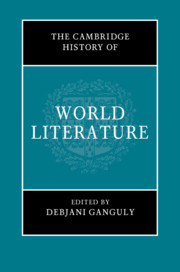Book contents
- The Cambridge History of World Literature
- The Cambridge History of World Literature
- Copyright page
- Contents
- Figures
- Contributors
- Acknowledgements
- Introduction
- Part I Genealogies
- Part II Thinking the World
- Part III Transregional Worlding
- Part IV Cartographic Shifts
- 22 The Multilingual Local: Worlding Literature in India
- 23 Oceanic Comparativism and World Literature
- 24 Mediterranean Worlds in the Long Nineteenth Century
- 25 Antipodal Turns: Antipodean Americas and the Hemispheric Shift
- 26 The Region as an In-between Space: Tomas Tranströmer’s Östersjöar and the Making of an Archipelagic Nordic Literature
- Part V World Literature and Translation
- Part VI Poetics, Genre, Intermediality
- Part VII Scales, Polysystems, Canons
- Part VIII Modes of Reading and Circulation
- Part IX The Worldly and the Planetary
- Index
- References
23 - Oceanic Comparativism and World Literature
from Part IV - Cartographic Shifts
Published online by Cambridge University Press: 17 August 2021
- The Cambridge History of World Literature
- The Cambridge History of World Literature
- Copyright page
- Contents
- Figures
- Contributors
- Acknowledgements
- Introduction
- Part I Genealogies
- Part II Thinking the World
- Part III Transregional Worlding
- Part IV Cartographic Shifts
- 22 The Multilingual Local: Worlding Literature in India
- 23 Oceanic Comparativism and World Literature
- 24 Mediterranean Worlds in the Long Nineteenth Century
- 25 Antipodal Turns: Antipodean Americas and the Hemispheric Shift
- 26 The Region as an In-between Space: Tomas Tranströmer’s Östersjöar and the Making of an Archipelagic Nordic Literature
- Part V World Literature and Translation
- Part VI Poetics, Genre, Intermediality
- Part VII Scales, Polysystems, Canons
- Part VIII Modes of Reading and Circulation
- Part IX The Worldly and the Planetary
- Index
- References
Summary
If world literature is conceived as a network of transregional, multi-local and transnational nodes stretching back to antiquity, oceanic worlds can be seen to offer a generative frame for literary history. The world’s oceans gird the shores of cities, nations, islands and continents. They generate contact zones that are multilingual, demographically mixed, economically varied and culturally hybrid. Further, much like world literature, the historicity of the oceans can scarcely be contained within the temporality of transatlantic capitalism from the eighteenth century to the present. This chapter explores literary works across several oceanic zones and offers oceanic comparativism as a rich cartographic frame for world literature.
- Type
- Chapter
- Information
- The Cambridge History of World Literature , pp. 429 - 457Publisher: Cambridge University PressPrint publication year: 2021
References
- 1
- Cited by

